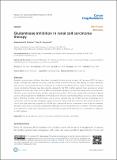Files in this item
Glutaminase inhibition in renal cell carcinoma therapy
Item metadata
| dc.contributor.author | Raczka, Aleksandra Maria | |
| dc.contributor.author | Reynolds, Paul Andrew | |
| dc.date.accessioned | 2019-05-16T08:30:01Z | |
| dc.date.available | 2019-05-16T08:30:01Z | |
| dc.date.issued | 2019-05-14 | |
| dc.identifier | 258606399 | |
| dc.identifier | 0d1a9318-e9e2-4649-a1ee-ac17ab35307d | |
| dc.identifier | 85074788612 | |
| dc.identifier.citation | Raczka , A M & Reynolds , P A 2019 , ' Glutaminase inhibition in renal cell carcinoma therapy ' , Cancer Drug Resistance , vol. 2 . https://doi.org/10.20517/cdr.2018.004 | en |
| dc.identifier.issn | 2578-532X | |
| dc.identifier.uri | https://hdl.handle.net/10023/17709 | |
| dc.description | This work was supported by the Melville Trust for Care and Cure of Cancer. | en |
| dc.description.abstract | Receptor tyrosine kinase inhibitors have been a standard first-line therapy for renal cell carcinoma (RCC) for over a decade. Although they stabilize the disease, they are unable to remove all tumor cells, leading to relapse. Moreover, both intrinsic and acquired resistance to therapy are a significant health burden. In order to overcome resistance, several combination therapies have been recently approved by the FDA. Another approach takes advantage of altered metabolism in tumor cells, which switch to alternative metabolic pathways to sustain their rapid growth and proliferation. CB-839 is a small molecule inhibitor of kidney type glutaminase (GLS). GLS is often upregulated in glutamine addicted cancers, enhancing glutamine metabolism for the production of energy and the biosynthesis of various cellular building blocks. CB-839 is currently in clinical trials for several tumors, including clear cell (cc)RCC, both as monotherapy and in combination with the approved therapeutic agents everolimus, cabozantinib and nivolumab. Early results of Phase 1/2 clinical trials look promising, especially for CB-839 plus cabozantinib, and all combinations seem to be well tolerated. However, cancer cells can activate compensatory pathways to overcome glutaminolysis inhibition. Therefore, genetic and metabolomic studies are crucial for the successful implementation of CB-839 alone or in combination in subgroups of ccRCC patients. | |
| dc.format.extent | 9 | |
| dc.format.extent | 510519 | |
| dc.language.iso | eng | |
| dc.relation.ispartof | Cancer Drug Resistance | en |
| dc.subject | Glutamine addiction | en |
| dc.subject | Renal cell carcinoma (RCC) | en |
| dc.subject | Combination therapy | en |
| dc.subject | Metabolism | en |
| dc.subject | RC0254 Neoplasms. Tumors. Oncology (including Cancer) | en |
| dc.subject | T-NDAS | en |
| dc.subject | SDG 3 - Good Health and Well-being | en |
| dc.subject.lcc | RC0254 | en |
| dc.title | Glutaminase inhibition in renal cell carcinoma therapy | en |
| dc.type | Journal item | en |
| dc.contributor.sponsor | The Melville Trust for the Care & Cure | en |
| dc.contributor.institution | University of St Andrews. Sir James Mackenzie Institute for Early Diagnosis | en |
| dc.contributor.institution | University of St Andrews. Cellular Medicine Division | en |
| dc.contributor.institution | University of St Andrews. Biomedical Sciences Research Complex | en |
| dc.contributor.institution | University of St Andrews. School of Medicine | en |
| dc.contributor.institution | University of St Andrews. Centre for Biophotonics | en |
| dc.identifier.doi | https://doi.org/10.20517/cdr.2018.004 | |
| dc.description.status | Peer reviewed | en |
| dc.identifier.grantnumber | M00108.0001/TZH/JGC | en |
This item appears in the following Collection(s)
Items in the St Andrews Research Repository are protected by copyright, with all rights reserved, unless otherwise indicated.

